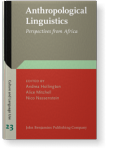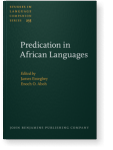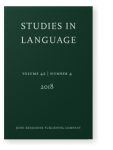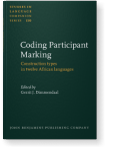Gertrud Schneider-Blum
List of John Benjamins publications for which Gertrud Schneider-Blum plays a role.
2024 Chapter 3. A cautious approach to spatial orientation in Tima Anthropological Linguistics: Perspectives from Africa, Hollington, Andrea, Alice Mitchell and Nico Nassenstein (eds.), pp. 49–82 | Chapter
This study investigates two subdomains within the semantic field of space among the Tima in Sudan: first, topology (and toponymy), and second, frames of reference. Like many European languages, Tima uses adpositions to indicate a goal/location and a source. Furthermore, Tima uses locative… read more
2024 Chapter 2. Locative expressions and their semantic extensions in Tima Predication in African Languages, Essegbey, James and Enoch O. Aboh (eds.), pp. 44–73 | Chapter
Tima (Niger-Congo, Sudan), has three copulae playing a central role in locative expressions. The number-sensitive copulae, ŋ̀kɔ́ ‘cop:sg’ and ɲ̀cɛ́ ‘cop:pl’, primarily link two non-verbal phrases. The third copula, ŋ̀kwíyʌ̀ ‘cop’, indicates existence or availability. We discuss the distribution… read more
2024 Chapter 9. Kin-relational expressions of the Tima (Nuba Mountains, Sudan) Anthropological Linguistics: Perspectives from Africa, Hollington, Andrea, Alice Mitchell and Nico Nassenstein (eds.), pp. 223–252 | Chapter
Tima, a language of the Nuba Mountains in Sudan, is severely endangered, as can be seen in many disappearing domains of the lexicon. One domain that is still relatively strong pertains to kinship. Continued use of this vocabulary can be linked to the high value still placed on social… read more
2018 Reference tracking in Tima and its interplay with split ergative marking Studies in Language 42:4, pp. 970–993 | Article
Tima, a Niger-Congo language of the Sudan, shows signs of split ergativity. If its constituent order deviates from the basic AVO order to OVA order, the postverbal agent is formally marked, unlike preverbal agents. A direct object, regardless of its position relative to the verb, is never marked. read more
2009 Alaaba Coding Participant Marking: Construction types in twelve African languages, Dimmendaal, Gerrit J. (ed.), pp. 55–96 | Article
Participant marking in Alaaba is mainly manifested in its case system. Eight cases can be differentiated with nouns: The Absolutive primarily encodes the direct object of a sentence and is used as the citation form of the noun. The Nominative is basically used to encode the subject of a sentence.… read more



